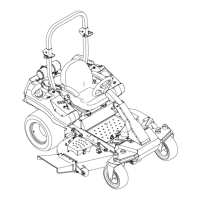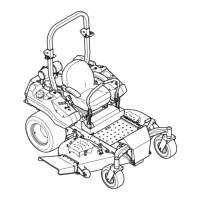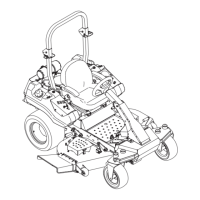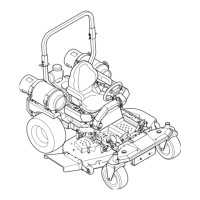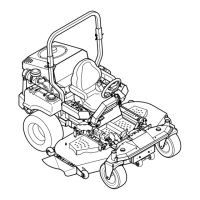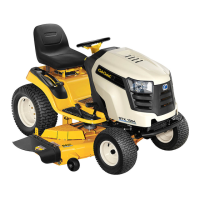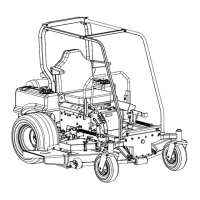32 se c t i O n 6— Ma i n t e n a n c e & ad j u s t M e n t s
Emptying the fuel system:c.
fuel consumption with the goal of running
the fuel tank empty.
Close the fuel tank shutoff valve. Disconnect
the fuel line from the carburetor and put the
end into an approved fuel container.
fuel tank and line into the approved container.
Reinstall the fuel line on the carburetor.
This will prevent gum and varnish deposits
from forming. Replace the fuel filter.
Remove the spark plugs and pour approximately one
ounce of oil into each cylinder. Crank the engine one or
two turns to spread the oil evenly on the cylinder walls.
Replace the spark plugs.
Clean the engine and the entire tractor thoroughly.4.
NOTE: Use of a pressure washer or garden hose is not
recommended to clean your tractor. They may cause
damage to electrical components, spindles, pulleys,
bearings or the engine. The use of water will result in
shortened life and reduce serviceability.
5.
when needed.
6.
oil on any unpainted surfaces including the pulleys and
Clean and fully charge the battery, then disconnect the 7.
negative cable at the battery to prevent possible discharge.
Recharge the battery periodically when in storage.
NOTE: Remove the battery if exposed to prolonged periods
where temperatures are above freezing.
Lubricate all lubrication points.8.
Inspect the hydraulic hoses, lines and fittings. Replace as
necessary.
off of the tires.
Removing The Tractor From Storage
Check the battery. Charge if necessary.
Lower tractor off blocks, and inflate the tires to the 2.
recommended pressure.
Remove the spark plugs and wipe them off. Using the
starter, crank the engine to pump the excess oil out of the
spark plug holes. Replace the spark plugs and the ignition
leads.
If drained before storing, fill the fuel tank with clean, fresh 4.
gasoline.
Check the level of the engine oil in the crankcase and the 5.
hydraulic reservoir tank.
Battery Storage
When storing the tractor for extended periods, disconnect
the negative battery cable. It is not necessary to remove
the battery.
All batteries discharge during storage. Keep the exterior 2.
of the battery clean, especially the top. A dirty battery will
discharge more rapidly.
The battery must be stored with a full charge. A discharged
battery can freeze sooner than a charged battery. A fully
charged battery will store longer in cold temperatures than
hot. Refer to chart below.
-62
5
Recharge battery when ever the specific gravity value is 4.
Tractor Storage
If your tractor is not going to be operated for an extended period
of time (thirty days to approximately six months), the tractor
protected location. If stored outside, cover the tractor (including
the tires) to protect it from the elements. The procedures
outlined below should be performed whenever the tractor is
placed in storage.
Change the engine oil and filter following the instructions
provided in the engine manual packed with this manual.
WARNING! Never store the tractor with fuel in the
tank indoors or in poorly ventilated enclosures,
where fuel fumes may reach an open flame, spark or
pilot light as on a furnace, water heater, clothes
dryer, etc.
2.
To prevent gum deposits from forming inside a.
malfunction of the engine, the fuel system must be
either completely emptied, or the gasoline must be
treated with a stabilizer to prevent deterioration.
WARNING! Fuel left in the fuel tank deteriorates
and will cause serious starting problems.
Using a fuel stabilizer:b.
and recommendations.
Add to clean, fresh gasoline the correct
amount of stabilizer for the capacity
Fill the fuel tank with treated fuel and run the
into the carburetor.

